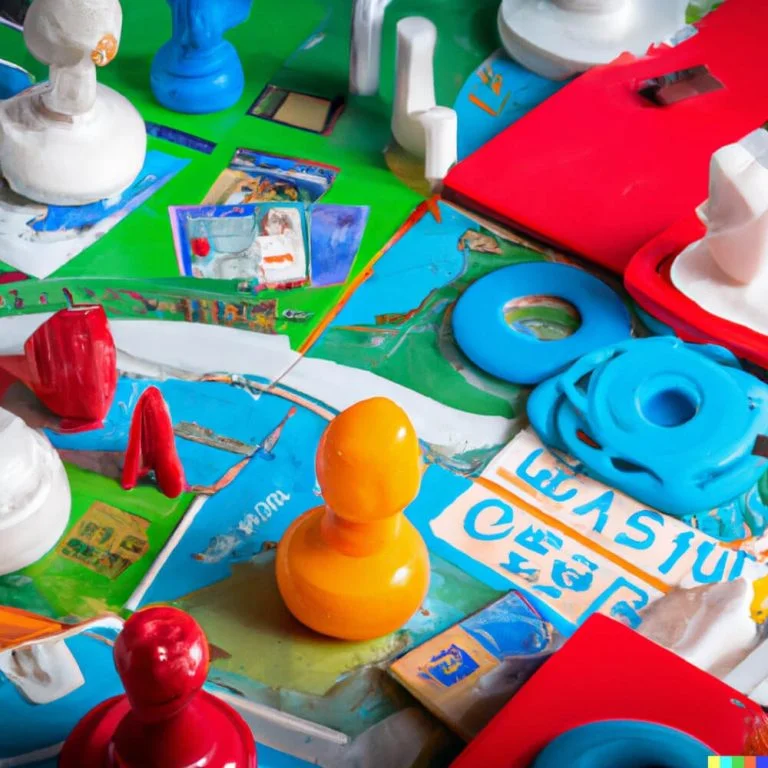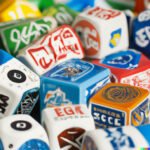Introduction
Creating a board game for school is an excellent way to teach students important concepts, as well as help them develop and practice crucial skills such as problem solving, teamwork, collaboration, creativity and critical thinking. Not only are board games fun for both students and teachers but they can also be incredibly effective teaching tools. Making your own board game not only saves you money but allows you to better customize the activity to fit your curriculum.
Step 1: Choosing a Topic
The first step in making a board game for school is to choose a topic that reflects the area of study you’re trying to teach or reinforce. Consider what type of knowledge or skill set you need your students to learn and brainstorm accordingly. For example, if you are teaching geography then it would be suitable to create a game that centers around different countries and their cities, rivers or population sizes. If it’s math-based, then perhaps something more complicated like multiplication tables could be utilized. Additionally, consider age appropriateness when choosing topics as some may be too complex based on the grade level you are teaching.
Step 2: Designing the Layout
Once the topic has been chosen it’s time to design out the layout of the boardgame which can vary greatly depending on the type of game that was chosen. Generally most tabletop games have distinct elements such as cards or dice alongside larger sections meant for pieces or tiles depending on what type of instructions is provided by players during playtime. Of course there will also be some sort of scoreboard to track points or other valuable aspects within the game itself. There should also be several distinct points during gameplay that offer different combinations so every attempt at playing won’t yield exactly the same result every time which helps engage students further while they practice and hone their skillsets.
Necessary Materials
To make a board game for school, you will need to gather the necessary materials including: scissors, card stock paper, markers, some colored pencils and crayons, ruler or measuring tape, pieces of fabric or felt for decorations, craft glue (or glue sticks), various game pieces such as dice or spinners, and any other type of additional décor that you would like to add.
Once you have gathered all the supplies listed above, it is time to plan out what type of board game you would like to create. Brainstorm possible themes or ideas that could be used for your project. Consider elements from books or movies you enjoyed, topics from school curriculum, or any other creative ideas that come to mind. After settling on a creative concept for your board game it is time to get started with the construction process.
Using cardstock paper make a template for the main game board where the players will travel along. Make sure that the squares and borders are even on all sides by using a ruler or measuring tape regularly while churning out your board design. Once completed draw on areas where each player’s character will start and end by adding in bold markings with colorful markers pens and/or crayons. Depending on the theme/ setup of your board design add in vibrant illustrations and/or state-of-the-art graphics with felt Fabrics / collages created with scissor cuttings and additional decorative pieces glued in place with craft glue (or glue sticks). Lastly use dice or spinners for movement control around the board option cards which can impede progress along its course causing obstacles within the playing field – this may require special rules if applicable. After everything is complete its time to enjoy your homemade school Board Game!
Research, Research, Research
Research ideas by learning about different board game genres and mechanics to find the one that best suits your educational topic. Think about what kinds of themes, characters, and visuals will best help illustrate the lesson for your student’s age group. Read up on existing reviews of popular games to get an idea of what works well to create enjoyable gameplay experiences.
Brainstorm: Make a List of Suitable Game Mechanics and Themes
Brainstorm ideas for game mechanics and come up with a story or theme you could use to make the board game feel more immersive. Consider including several theme-relevant topics within the game such as historical context, scientific concepts, or character development. Also think about ways to incorporate different complexities within the game such as luck versus skill, problem solving challenges, trivia questions etc..
Create Components: Visualize and Create Each Element of The Game With Relevance In Mind
Create all visual components needed for the game. Ensure that graphics are visually attractive to keep students engaged throughout gameplay. Use relevant pictures/ images when it comes to card designs depending on which approach you are using within your lesson plan. Design each piece according to important elements on your board layout so they can be easily identified while playing the game.
Design Board Layout: Arrange Components Into an Interactive Playable Space
Once all components have been designed, it is time to think about how everything should be arranged into an interactive playable area. You will need several types of spaces such as squares occupied by pieces or cards; paths for moving pieces around; hazards like snakes or ladders; and items associated with bonuses/penalties (e.g., coins). When creating a board layout also think about neat presentation styles that could look appealing for students/suspenseful for competitive players!
Structure
1. Choose the central theme of your board game. This should be related to your school subject in some way.
2. Gather the materials you need to make the gameboard and game pieces, such as cardstock, markers or colored pencils, scissors, dice, etc.
3. Draw a gameboard based on your chosen theme that fits on one piece of cardstock. Create squares or other shapes where players will move their pieces when they play the game.
4. Create game pieces for each player to use (these could be shaped like school items such as books, pens, notebooks), customizing each set with different colors for unique identification.
5. Design cards for players to draw if they land on certain squares, catching up or advancing (or both!) depending on the task accomplished by solving a riddle or answering a question correctly from your subject matter field.
6. Create rules and instructions and print them off so all players can read them before starting their journey through the board game and know how it works!
Rules and Directions
Making a board game for school that is both fun and educational can be a great way to give students an other option for learning. The first step to creating successful board game is to decide on rules and directions.
When it comes to the actual gameplay, take some time to consider the restrictions or limitations of the board game. What are some objectives you would like your players to achieve? Are there particular actions that need to be taken at certain points in order progress through levels? Are there certain risks or rewards for particular outcomes? All these factors should be made clear in the instructions so that everyone is on the same page when playing.
It is also important to consider how the different players will interact with each other within the game. Though many board games are centered around individual play, team-based games can be a more engaging experience. Questions such as how turn order will determined, how scores should be kept track of and who gets eliminated when should all be addressed in your rules and guidelines.
Lastly, make sure your written rules are easy to comprehend! When writing them out make sure they are easily accessible, yet detailed enough that all participants understand what’s being asked of them. Providing examples or diagrams may also help with understanding various elements of gameplay.
Testing and Troubleshooting
Making a board game for school can be challenging, but it can also be a rewarding experience. After you’ve gone through the process of designing and creating your game, you’ll need to test and troubleshoot it before you can use it in class. Here are some tips for finding and fixing problems with your board game:
1. Test Your Game with Different Players: Playing your board game with people who have different levels of knowledge about the subject material can quickly reveal any issues with clarity or instruction. Have each person take turns playing the game and offer feedback on how clear they found the rules and instructions.
2. Reassess Critical Spaces: Look at critical spaces on your game board that are integral to gameplay, particularly if they involve integral pieces such as cards or dice rolls. Make sure these spaces don’t lack direction or cause confusion when players land on them.
3. Vary Speed of Play: To have an accurate understanding of how long your board game will take for full gameplay, play through it several times at different speeds to get a realistic idea. If a player’s turn ends too early or too late into their designated turn time it can make the experience unsatisfying, so adjust your turn settings accordingly.
4. Test Balance: Playtest with an eye open for appropriate balance between risk versus reward — there shouldn’t be any hugely beneficial spots or spaces where players always gain advantage without consequence; fairness is key here! Also consider balance between difficulty and complexity — if two players of different skillsets find themselves in conflict over how to play, you might want to reexamine difficulty levels to ensure that each participant has equal access to fun and challenge during the course of gameplay.
5. Read Instructions Aloud: Another test that many don’t think about is reading the instructions aloud while another “player” follows along behind them on the first round instead of reading it silently themselves which makes things even more complicated than they initially seem! This ensures all directions are being comprehended correctly by both parties involved correctly while nothing goes amiss due to miscommunication during turns passed around the group as well!
Finalizing
Once you have crafted all the pieces of your board game, it’s time to review them to ensure everything is ready for play. Read through the instructions and game play scenarios to make sure that they are clear and easy to follow. Ensure all pieces (cards, playing pieces, etc.) are undamaged and can be used without any complications. Place the material in a container or box that can be easily transported if you plan on displaying or teaching it in a classroom setting. For enhanced protection, tape the cover shut or add a seal – this will help prevent any surprises opening in transit. Finally, make sure you have enough copies of the rules so everyone playing can get familiar with how to play your game. By taking these steps before diffusion, you will guarantee that players experience what you envisioned: a fun, informative gaming experience!
Celebrating
Making a board game for school can be a great way to get students engaged in learning activities and build their enthusiasm for the subject matter. Once you’ve created the game, it’s important to recognize their hard work and highlight their accomplishments. Here are some ideas for celebrating a successful board game for school:
• Have an award ceremony: Reward participants with special awards or certificates that recognize their accomplishment of completing the project. Include accolades from any teachers or school administrators who helped with the development of the game.
• Throw a party: Celebrate completing your board game project by throwing a party. Make sure to include all of the participants in the planning and decorations. This will help them feel appreciated and reward them for all of their hard work on the project.
• Offer extra credit points: Give students extra points on a future assignment if they designed part of the game or participated in its creation. Adding bonus points will encourage future collaboration and engagement in creating educational activities like this one.
• Put up posters advertising the board game around school: Communicating student achievement should be done throughout your school community. Placing posters with catchy slogans or artwork can be a great way to do that.
• Invite other classes to play: Invite other classes from your school or even from other schools to come play your board game during recess periods or at extracurricular events. This will help spread knowledge about what was accomplished, as well as generate interest for similar projects in the future.
Wrap Up
Making a board game for school can be a great way to get children engaging with the material, have fun, and learn in an entertaining way. To begin making your own board game, you’ll need to design a basic game concept and choose what kind of game pieces will be used. Once those decisions are made, the task of creating the actual board will require printing supplies such as cardstock paper or posterboard and something to draw on, like markers or crayons. The majority of the work will come in designing how players will move through the board and how each turn should progress; it may help to think about how your students would interact with the game. Finally, you’ll need ways for players to win or lose by implementing rules and additional components that make sense with your overall concept. If desired or needed, add fun educational elements such as trivia questions embedded within the board that when reached must be answered correctly in order to progress further into the game play.
Now that your board game is complete, why not plan a session where your classroom can test it out? Eve before attempting a full-on gameplay session, allow someone else to peruse it and take notes on anything they might deem confusing or unplayable so you can tweak them accordingly beforehand. Assemble all necessary materials so they are readily available during gameplay — such as dice (if needed) and pens/pencils — then invite willing participants to try out your creation! Consider recording any hiccups in rules that might have occurred during their session so you can better hone them before attempting another playthrough with other students. Lastly, be sure to bask in your students’ enthusiasm for what you’ve created when everyone enjoys themselves! Making a board game for school may sound daunting at first but once given enough attention and consideration its rewards are well worth it!

I love playing all kinds of games – from classics like Monopoly to modern favourites like Ticket to Ride.
I created this blog as a way to share my love of board games with others, and provide information on the latest releases and news in the industry.





